Front Shoulder Pain Symptoms and Your Treatment Options
Get Help With Front Shoulder PainFront shoulder pain is a disabling complaint commonly seen in the doctor’s office, with a lifetime prevalence of 70% (1). It is a treatable condition within the shoulder joint. If left untreated, the recovery can be awfully slow, with high recurrence rates. There are many causes of pain in the front of the shoulder joint. The key is to identify what causes front shoulder pain and diagnose it promptly.
We will discuss how front shoulder pain occurs, how it can be treated, and when you need to see your doctor.
What Are the Parts of the Front Shoulder?
The shoulder has three major bones:
- Humerus: the long arm bone
- Scapula: also known as the shoulder blade
- Clavicle: also known as the collarbone
The shoulder has two principal joints:
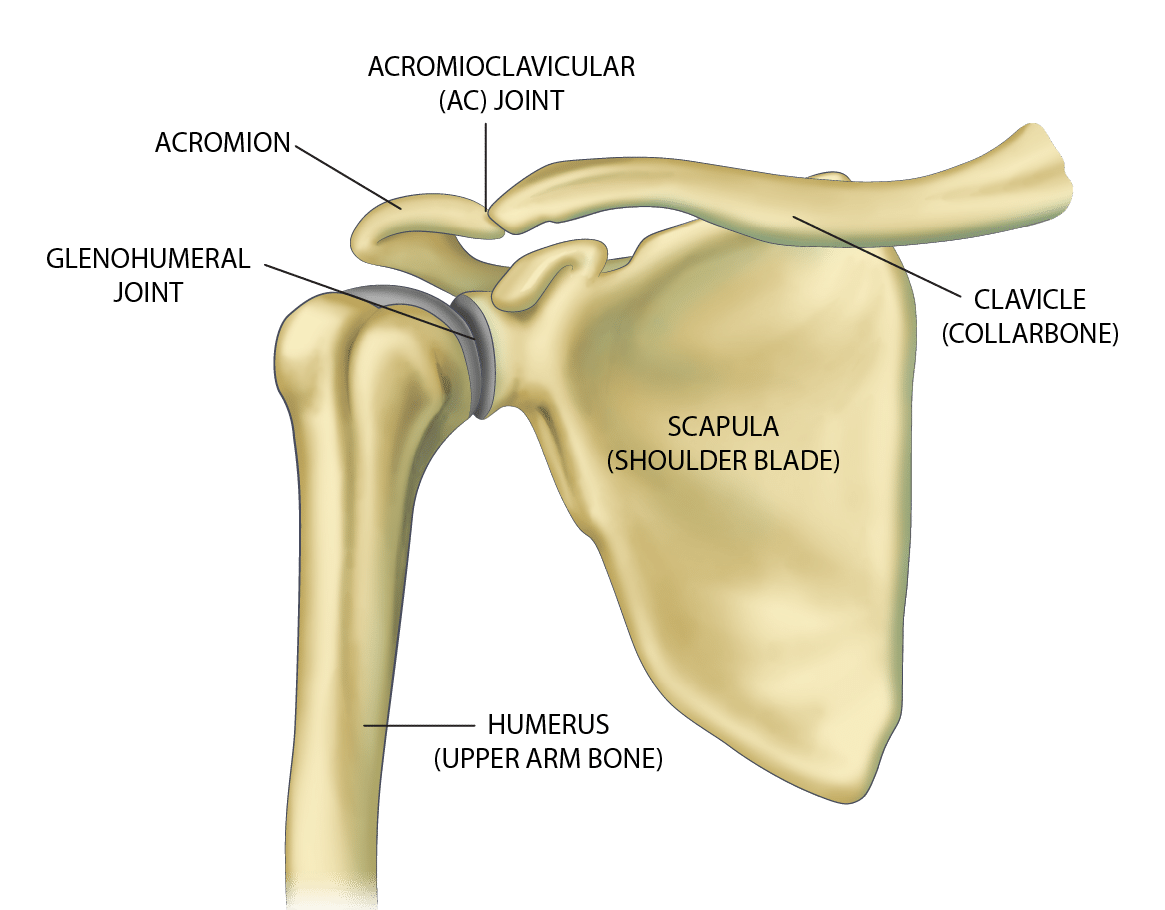
- Glenohumeral: A ball and socket joint comprising the humerus and the glenoid (socket).
- Acroclavicular joint (AC joint): A small joint immediately above the glenohumeral joint that is formed by the union of the acromion and collar bone.
Let’s understand the parts of the shoulder in detail.
- Muscles
There are a whole host of muscles in the shoulder joint. This includes the deltoids, teres major and minor, supraspinatus, infraspinatus, subscapularis, trapezius, latissimus dorsi, levator scapulae, rhomboid major and minor, pectoralis major and minor, subclavius, coracobrachialis, biceps brachii, and triceps brachii.
- Rotator cuff
The rotator cuff is a group of four muscles and their associated tendons that stabilize the arm bone within the shallow shoulder joint, allowing for a wide range of arm movements. These muscles and tendons work together to keep the head of the humerus securely within the shallow socket of the shoulder blade.
The four muscles are:
- supraspinatus
- infraspinatus
- subscapularis
- teres minor
The supraspinatus, infraspinatus, and subscapularis tendons attach to the front (anterior) portion of the humerus bone. Injuries to any of these rotator cuff muscles can result in front shoulder pain.
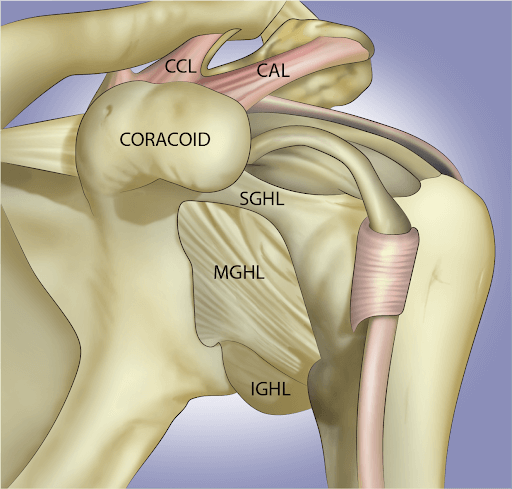
- Ligaments
Four main ligaments reinforce the shoulder joint. These are the glenohumeral ligaments, coracoacromial ligament, coracoclavicular ligaments, and the transverse humeral ligament.
Each of these ligaments ensures that the clavicle, scapula, and humerus allow movement across different planes while passively stabilizing the joint.
Ligaments are thick pieces of connective tissue that provide stability for the joint. They prevent the shoulder from subluxing, or being dislocated. The major ligaments are the superior, middle, and inferior glenohumeral ligaments.
- Nerves
The front shoulder nerve supply is from the subscapular, axillary, and lateral pectoral nerves. Each of these nerves branches from the C5-C6 root of the axillary nerve. These nerves innervate the muscles and ligaments of the shoulder joint.
Injuries to the muscles and ligaments lead to pain across the muscle fibers and result in front shoulder pain. Additionally, if the nerves are impinged or trapped, then a person can experience pain in the front of the shoulder.
Nerves that supply each of the muscles of the joint carry pain sensation back to the brain. Therefore, any injury to any muscle or tendon within the shoulder joint can cause front shoulder pain.
Types of Pain That Occur in the Front Shoulder
Various symptoms can occur because of injury or dysfunction to the front shoulder joint. Pain is a broad symptom that can encompass anything from a dull ache to a burning or stinging sensation. Pain can cause difficulty with lifting heavy loads, decreased strength, and even decreased mobility of the joint.
The following are the different types of pain that can occur in the front shoulder, and what may cause it:
- Aches
Dull aching pain in the front of the shoulder is often persistent and can be felt deep within the joint. This pain may worsen with specific movements such as lifting the arm, reaching overhead, or carrying objects. It can also be accompanied by stiffness and limited range of motion, making everyday activities uncomfortable.
It can stem from various sources, including rotator cuff injuries and shoulder arthritis. - Stinging pain
Sharp, stinging pain in the shoulder joint can be caused by trauma to the joint, a dislocation, fracture, a severe tear in the muscles or ligaments, nerve impingement, joint infection, or tissue death (necrosis). All of these conditions can cause intense, stinging pain that does not subside with rest or over-the-counter medication. - Burning
Typically, burning pain or a burning sensation in the shoulder joint is seen in conditions such as bursitis, tendonitis, and arthritis of the joint. This is a classic sign of inflammation and also occurs when the joint is infected. - Swelling
A lump or swelling in the shoulder joint can indicate a fracture, a dislocation, rheumatoid arthritis, osteoarthritis, or even a severe tear in the rotator cuff muscles. The swelling can be sudden or may develop gradually over a period of time.
Symptoms of Pain in the Front of the Shoulder Joint
Along with pain in the front shoulder, other signs and symptoms can indicate a severe injury of the shoulder.
Here is a detailed list of what else to look for when you have pain in front of the shoulder joint:
- Decreased strength in the arm
- Inability to carry objects
- Visible deformity of the clavicle, shoulder, or humerus that results from trauma or injury
- Pain that worsens at night or while resting
- Persistent pain that does not go away after two weeks
- Inability to raise the arm either overhead or beyond a certain degree
- Swelling or bruising around the shoulder area
- Signs of infection or inflammation (e.g., fever, redness, warmth)
- Numbness or paralysis
- Clicking, grinding, or popping sounds when you move the arm
Conditions That Cause Pain in the Front of the Shoulder
Front shoulder pain can be debilitating, compromising quality of life and daily function. The most common causes of front shoulder pain include:
Rotator Cuff Injuries
Rotator cuff injuries can cause pain in the front of the shoulder due to the involvement of the tendons and muscles that stabilize and move the shoulder joint. The rotator cuff consists of four muscles and their tendons, which surround the shoulder joint, allowing for a wide range of motion while keeping the joint stable.
The supraspinatus and infraspinatus muscles/tendons attach to the front of the arm, immediately adjacent to the biceps tendon. The supraspinatus tendon inserts on a bony prominence called the greater tuberosity. The subscapularis tendon also attaches to the front of the arm at the lesser tuberosity. Irritation or tearing of these rotator cuff tendons can cause front shoulder pain.
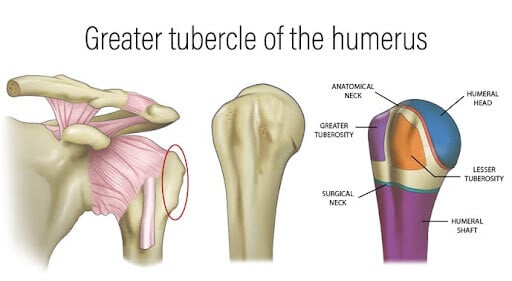
Bicep Tendonitis
The biceps tendon is a strong, fibrous cord that connects the biceps muscle to the bones in the shoulder and elbow.
The bicep muscle, also known as the biceps brachii, has two distinct heads: the short head and the long head.
Specifically, the long head of the biceps tendon attaches to the top of the shoulder socket (the glenoid), while the short head attaches to the coracoid process of the shoulder blade. The tendon of the long head of the biceps travels through the bicipital groove of the humerus, where it is susceptible to wear and tear, inflammation, and injury.
Bicep tendonitis is inflammation or injury of the biceps tendon. Front shoulder pain associated with the biceps tendon, often referred to as biceps tendinopathy, arises when the tendon becomes inflamed or irritated due to repetitive overhead activities, heavy lifting, or traumatic injury.
This inflammation can cause pain in the front of the shoulder that worsens with activities involving arm lifting, reaching, or carrying objects.
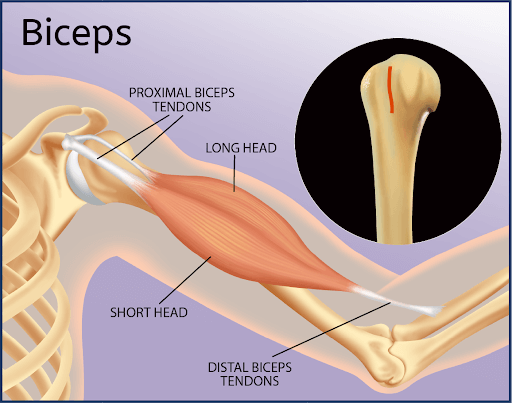
Biceps Tendon Rupture
A biceps rupture occurs when the tendon that attaches the biceps muscle to the shoulder or elbow tears. There are two primary types of biceps ruptures:
Proximal biceps tendon rupture: This occurs at the shoulder and involves the long head of the biceps tendon. A rupture here can cause significant pain in the front of the shoulder.
Distal biceps tendon rupture: This occurs at the elbow and involves the tendon that attaches the biceps muscle to the radius bone in the forearm. While this type of rupture typically causes pain at the elbow, it can occasionally cause referred pain in the front shoulder.
SLAP Tears
A SLAP tear lesion is a specific type of injury to the shoulder joint’s labrum. SLAP stands for “superior labrum anterior to posterior.” This term describes the location and nature of the tear in the shoulder’s labrum.
The labrum is a ring of cartilage that surrounds the socket of the shoulder joint (glenoid), helping to stabilize the joint. Here’s a detailed explanation of a SLAP tear lesion:
Anatomy of the shoulder and labrum
- Glenoid: The shallow bony socket that the head of the upper arm bone (humerus) fits into.
- Labrum: The fibrocartilaginous rim attached around the margin of the glenoid, providing stability and cushioning the joint.
- Biceps tendon: The tendon of the long head of the biceps brachii muscle attaches to the superior part of the labrum.
Causes of SLAP tears
- Trauma: Direct trauma, such as a fall on an outstretched arm or a sudden pull on the arm.
- Repetitive overhead movements: Common in athletes like baseball pitchers and swimmers.
- Degeneration: Wear and tear from aging.
SLAP lesions can cause front shoulder pain that is deep and aching and often exacerbated by overhead activities, lifting, or throwing.
Shoulder Osteoarthritis
Shoulder osteoarthritis (OA) is a degenerative joint disease characterized by the breakdown of cartilage in the shoulder joint. It primarily affects the glenohumeral joint, which is where the head of the humerus (upper arm bone) meets the glenoid (the socket of the shoulder blade).
Over time, the cartilage that cushions these bones wears away, leading to pain, stiffness, and reduced function.
Front shoulder pain in patients with shoulder osteoarthritis is often due to:
- Loss of cartilage
- Bone spurs
- inflammation of the synovial membrane (synovitis)
- Joint space narrowing
- Rotator cuff and biceps tendon irritation and inflammation
Instability
Shoulder instability is a medical condition where the shoulder joint is loose and moves out of its normal position. The stability of the shoulder joint is dependent upon muscles and ligaments. The principal shoulder ligaments are the superior, middle, and inferior glenohumeral ligaments.
Accordingly, instability can occur if the ligaments, tendons, and muscles are stretched, injured, torn, or weakened.
Front shoulder pain due to shoulder instability can occur due to dislocation or subluxation of the shoulder joint, inflammation, muscle strain, and nerve irritation.
Dislocation
Shoulder dislocation (1) is a medical condition where the head of the upper arm bone (humerus) completely comes out of its socket (glenoid) in the shoulder blade. The shoulder joint is the most frequently dislocated major joint in the body because of its wide range of motion and relatively shallow socket.
There are three principal types of dislocation: anterior, posterior, and inferior.
Major causes of shoulder dislocation include trauma, repetitive strain, and genetics, as some patients have loose ligaments and joints (examples include Ehlers-Danlos syndrome (EDS).
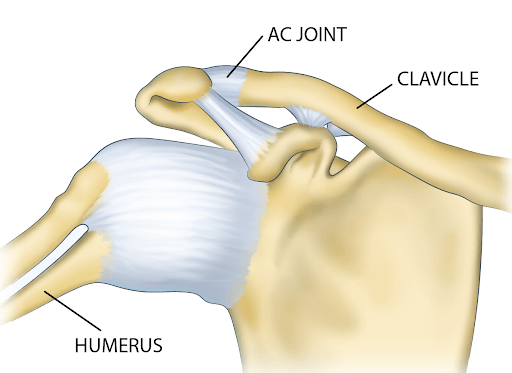
AC joint injury
The acromioclavicular joint is a small joint in the shoulder where two bones meet:
- Acromion: The highest point of the shoulder blade (scapula)
- Clavicle: Also known as the collarbone
This joint is held together by ligaments and is involved in various shoulder movements, providing stability and allowing the shoulder to move in multiple directions.
The major causes of AC joint pain are AC joint separation, arthritis, inflammation, and clavicular fractures.
Referred pain from the neck
Cervical neck injuries can cause front shoulder pain. Common cervical spine conditions leading to pain in the front of the shoulder include:
Cervical disc herniation: When a disc between the vertebrae in the neck herniates, it can press on nearby nerves, causing pain that radiates to the shoulder.
Cervical spine osteoarthritis: Degenerative changes in the cervical spine can lead to bone spurs and disc degeneration, which can irritate or compress nerves.
Cervical stenosis (narrowing): Narrowing of the spinal canal in the cervical spine can compress the spinal cord and nerve roots, leading to referred pain in the shoulder.
Cervical radiculopathy: This medical condition occurs when a nerve root in the cervical spine is irritated or compressed, leading to pain that can radiate from the neck to the shoulder and arm.
Common Causes of Front Shoulder Joint Pain
There are many causes of front shoulder joint pain. Here is a list of the probable causes:
Injuries
An accident or trauma to the shoulder joint can dislocate the shallow ball and socket joint. High-speed collisions, accidents, falling on an outstretched arm, or a sudden violent twist can fracture the scapula or humerus. Injuries can also tear the rotator cuff muscles and ligaments, leading to pain in the shoulder joint.
Repetitive Movement
Repetitive occupational movements of the joint can also cause front shoulder pain. For example, sports that require excessive overhead motions can cause front shoulder pain in athletes, such as swimmers, tennis players, basketball players, and weightlifters. People in occupations that require heavy lifting or overhead tasks frequently experience front shoulder pain too.
Aging
As a person ages, degenerative changes occur in the joints and the tissues. These changes can also lead to microtears in the muscle fibers. Rotator cuff tendonitis and arthritis can subsequently develop, causing front shoulder pain. In the older demographic, muscle repair can take time, so recovery is often much slower.
Common Treatment Options
There are many treatment options for front shoulder pain. There is no reason to live with this pain, no matter what age. Initially, you can try conservative treatment or over-the-counter medications. If they do not help, you may need to see a doctor to get some prescription medication.
Conservative Solutions
Conservative treatments and non-prescription solutions are the best first step for front shoulder pain. This can involve any one of the following:
- Rest: Rest from aggravating activities can be beneficial to people with front shoulder pain. Without the exacerbating activities, whether that is an occupation or sport, the injury can have time to heal and help the pain subside.
- Ice/heat: In the case of an injury, ice can be immensely helpful, especially within the first 72 hours. Ice to the affected area can help the pain and swelling subside. Conversely, if the shoulder feels very tense or tight, heat can be applied.
Heat is helpful more for chronic injuries or long-standing pain. If you’re not sure when to ice or when to heat, speak to your physician or schedule a telemedicine consult with one of our board-certified physicians. - Medication: Medical treatment of front shoulder pain can include non-steroidal anti-inflammatory (NSAID) medications. These are usually prescribed in conjunction with physical therapy modalities. NSAIDs only relieve or reduce pain.
Some common examples of NSAIDs are Motrin®, Advil®, Motrin IB®, Naprosyn®, and Aleve®. These medications should be avoided, given their significant side effects.
Therapy and Other Modalities
Once you meet with your doctor, they may prescribe other modalities to treat the cause of your front shoulder pain. The doctors will decide which treatment is best for you based on your diagnosis and what is causing your front shoulder pain.
Some of these solutions include:
- Physical therapy: Physical therapy (PT) is the first-line treatment for tendonitis of the rotator cuff. Some patients may benefit from physical therapy exercises alone, once diagnosed. Physical therapy of the shoulder joint involves a range of motion exercises as well as stabilizer and strengthening programs.
- Steroid injections: When conservative treatments fail to provide significant or sustained benefit, the patient may be referred for a steroid injection. Steroids are powerful anti-inflammatory agents. Common examples include prednisone, triamcinolone, and methylprednisolone.
Steroids do not address or heal the underlying condition but rather simply reduce inflammation, thereby providing only temporary relief.
They are also associated with significant side effects including immune function suppression, reduction of local stem cell numbers, compromised tendon healing, increased incidence of bone death, alteration of blood glucose and insulin sensitivity, and damage to cartilage, and for these reasons should be avoided.
In some cases, these injections are given with local anesthetics. However, it is important to keep in mind that high concentrations of long-acting local anesthetics, such as lidocaine, are chondrotoxic or harmful to the cartilage. - Surgery: Depending on the cause of the front shoulder pain, surgery may be a suitable treatment. For fractures and full-thickness tears with retractions in the rotator cuff, surgical repair may be necessary.
Surgery should never be a first-line treatment, given the number of risks, which include bleeding, infection, failure, escalation in pain, nerve damage, and altered biomechanics. When possible, all conservative treatment options should be exhausted prior to considering surgery.
Our Treatment Solutions
At the Centeno-Schultz Clinic, we are experts in the treatment of shoulder injuries, including front shoulder pain. It starts with a comprehensive review of your symptoms and past medical and surgical history.
A physical examination is performed, evaluating range of motion and strength. An in-office ultrasound is often utilized to evaluate the shoulder and its stability. Radiographic studies are then reviewed. All this information is used to provide an accurate diagnosis.
High-dose steroids and medications such as NSAIDs are not utilized, as they do NOT address the underlying injuries and may actually aggravate them.
Treatment options include customized platelet-rich plasma (PRP) and bone marrow concentrate that are injected using X-ray or ultrasound guidance to ensure proper placement and maximal healing.
When to See a Doctor
If you have shoulder pain, how long is too long? Ideally, you should see the doctor as soon as you have shoulder pain, just to make sure it is not something serious. Most people like to wait and treat themselves conservatively with rest, ice, and over-the-counter medications. This is good for minor tears or injuries.
However, here are some circumstances when you must consult a doctor for front shoulder pain:
- Visual deformity of the joint: If the joint is bent out of shape, then you could be dealing with a fracture or dislocation that needs immediate treatment.
Additionally, if you need to support the arm, then the injury should be looked at right away. This type of injury could potentially require a surgical reduction or repair that must be overseen by a trained orthopedic specialist. - Intense pain: If pain in the front of the shoulder keeps worsening, despite over-the-counter meds, rest, and ice, it may be time to seek help. If the pain persists even without movement, is accompanied by numbness or paralysis, or changes from an ache to severe pain, then consult your doctor immediately.
- Inability to use the arm: Front shoulder pain that leads to an inability to use the arm in its full range of motion needs medical attention. If you find that your shoulder has decreased strength, weakness, or suddenly drops while in use, then this might signal severe injury that requires medical attention.
- Swelling: If your shoulder joint is swollen and red, it means it is inflamed and should be seen by a medical doctor. These could also be signs of infection, inflammation, or sepsis within the joint and need to be treated immediately.
Septic arthritis is dangerous – if there are microbes in your joint, they can quickly travel through your bloodstream and make your whole body septic, which can be fatal. Therefore, a swollen joint should not be ignored.
What the Doctor Will Request for Diagnosis
The doctor will meet you and take an extensive history, conduct a physical exam, and use diagnostic tests to identify what is causing the front shoulder pain.
- History: They will want to know details about when your front shoulder pain started, if there was a history of trauma, what is the relationship of the pain to movement, is your dominant or non-dominant arm affected, is the pain bilateral, does it radiate, how long does it last, is it accompanied by exacerbating or relieving factors, what is the functional impact, and does it affect your sleep.
They will also take a careful occupational history including the nature of the occupation and how long you’ve been in the role. - Physical exam: After a detailed history, the doctor will also complete a thorough examination, a neurological assessment of both upper limbs, and a full musculoskeletal assessment. The doctor will also check for swelling, redness, scars, and dislocation.
They will test active and passive motion through the full range of shoulder movement. Clinical tests, such as the drop arm test for rotator cuff tears, are highly specific for certain pathologies and are done to confirm them. - Imaging: Injuries to the shoulder joint can be imaged using X-ray, ultrasound, MRI (magnetic resonance imaging), or MRA (magnetic resonance angiography). X-rays are used for fractures and dislocations. Ultrasound and MRI are the best for assessing soft tissue injuries, such as rotator cuff tears and ligament tears. Arthrography is the only option for joint capsule damage.
You Can Be Free of Front Shoulder Pain
The shoulder joint is a complex joint. It needs to be stable, yet also flexible and mobile. It functions along many different planes, but that is also what makes it vulnerable to injury.
If you have front shoulder pain, there are solutions to help it get better.
When identified early and diagnosed correctly, there are various treatment options for pain in front of the shoulder joint. With the right input, there is every chance of recovery, without the need for a prolonged recovery or risk of recurrence.
Get to know your shoulder pain. Consult one of our experts today!
References:
1. Cadogan A, Laslett M, Hing WA, McNair PJ, Coates MH. A prospective study of shoulder pain in primary care: prevalence of imaged pathology and response to guided diagnostic blocks. BMC Musculoskelet Disord. 2011;12:119. Published 2011 May 28. doi:10.1186/1471-2474-12-119
